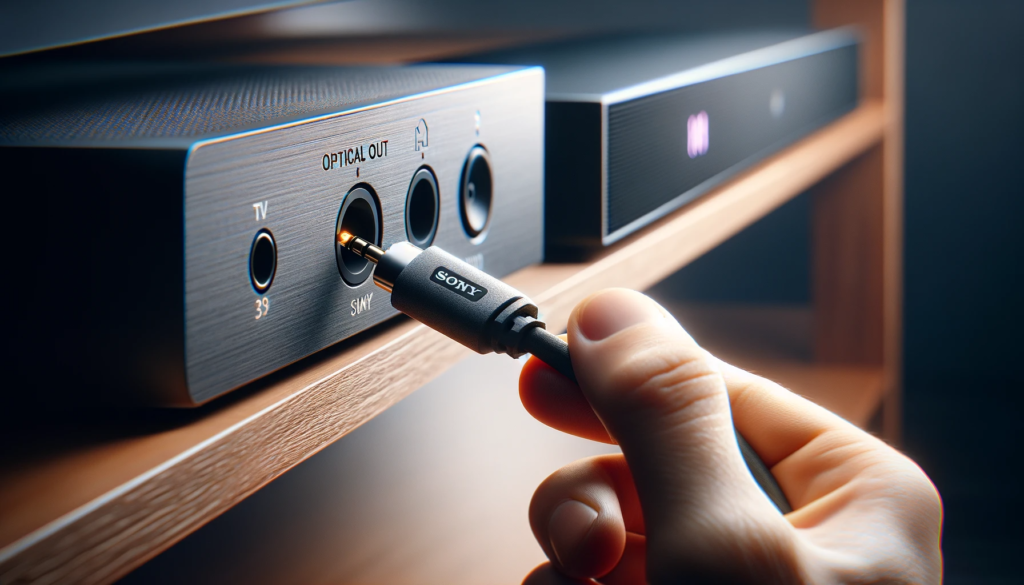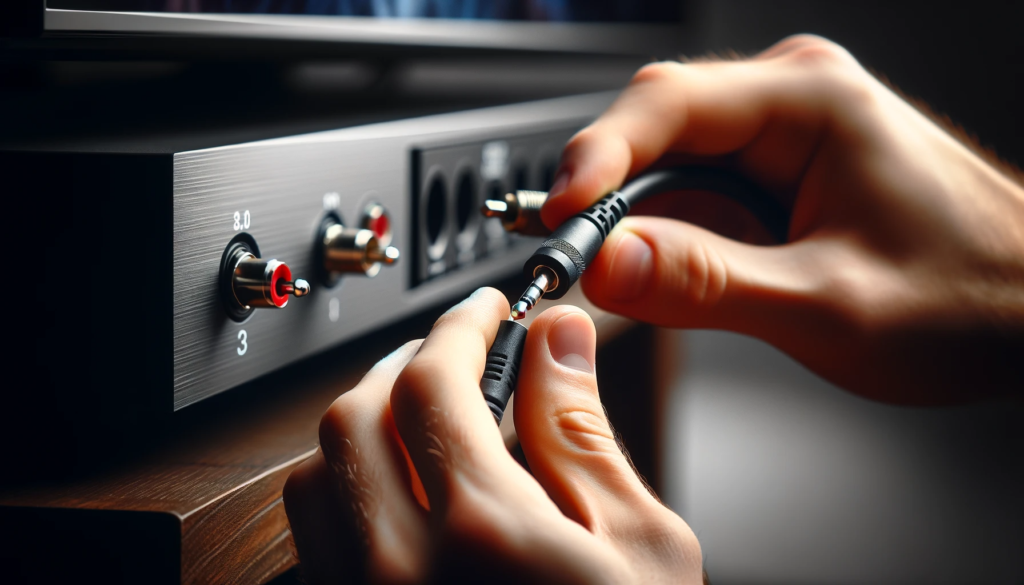Struggling to hear crisp dialogue and booming sound effects from tiny TV speakers?
Connecting a Sony soundbar is the solution for serious home theater audio immersion.
Let’s dive into determining compatibility, setup steps for HDMI, optical, analog and wireless connections, plus audio settings tweaks for the best performance.
How to Connect a Sony Soundbar to a TV

Connecting a Sony soundbar to a TV involves just 1 step: use the appropriate cable to connect the TV’s audio output port to the matching audio input port on the Sony soundbar.
Most often, an HDMI ARC, Optical, Analog or Bluetooth connection will be used.
Simply enable the corresponding audio output setting on the TV and audio input setting on the soundbar after connecting with the proper cable between the ports.
Choose the input and output signal path and the devices will interface for TV audio playback through the soundbar’s speakers.
Determine Compatibility

It is important to first check that your Sony soundbar and TV are compatible for connecting together before purchasing any cables or trying to set up the connection.
There are a few quick checks you can make to verify compatibility.
First, consult the instruction manuals or specifications list for both your Sony soundbar and your TV.
There should be a section that covers compatible audio inputs and outputs.
Most Sony soundbars will list options such as HDMI ARC, optical/TOSLINK, analog via RCA cables, Bluetooth wireless, or a headphone jack.
Your TV manual will outline what audio output options are available in the ports, often listing options such as HDMI ARC, optical digital audio out, RCA analog stereo audio out, a headphone jack, or Bluetooth capabilities.
By cross referencing the inputs on the soundbar and outputs on the TV, you can determine which connection methods they share.
Connect via HDMI ARC

If both your Sony soundbar and TV have HDMI ARC ports, this is the preferred connection method to transmit digital multi-channel audio from the TV to the soundbar.
HDMI ARC stands for Audio Return Channel, and uses a single HDMI cable to send audio in both directions.
To hook up your Sony soundbar to your TV with HDMI ARC, first locate the correct ports on both devices.
The ARC designated HDMI port on a TV or soundbar is usually labeled as such.
If not clearly labeled, it is most often one of the HDMI inputs/outputs that is closest to the other audio jacks or speaker terminals on the device.
You will need an HDMI cable, preferably high speed HDMI for optimal performance.
With the devices powered off for safety, connect one end of the HDMI cable to the HDMI ARC port on the soundbar.
Then connect the other end of the cable to the HDMI ARC terminal on the TV.
Some older TVs may not have a dedicated HDMI ARC port, but rather one of the HDMI ports can function as ARC when enabled in the settings.
If this is the case, try connecting to various HDMI inputs and check for an ARC option within audio settings.
Once everything is securely connected, power both the TV and soundbar back on.
The initial setup process differs slightly depending on the specific models, but there will be an option to enable HDMI-CEC and ARC functionality.
This allows the devices to send audio back and forth over the single HDMI cable as needed.
On your TV audio settings menu, ensure you have options like System Audio Control, Audio Return Channel, and HDMI-CEC enabled for the input port used.
Similarly, locate these settings within the appropriate menu on the Sony soundbar and enable ARC functionality.
In most cases, HDMI-CEC also allows your TV remote to directly control volume adjustment on the connected soundbar once enabled properly.
This convenient feature means you only need one remote to power on/off and control volume levels for both TV and soundbar in tandem when paired via HDMI ARC.
With everything enabled, audio from TV streaming apps, disc players, game consoles or over-the-air broadcasts should automatically output through your Sony soundbar speakers.
Connect via Digital Optical Cable

If your Sony soundbar or TV lacks HDMI ARC ports, the next best digital audio connection option typically involves use of an optical/TOSLINK cable.
Optical cables transmit pristine uncompressed digital audio between components.
This allows you to send stereo PCM signals or encoded Dolby Digital and DTS surround formats from TV to soundbar properly.
To hook up a Sony soundbar with TV via digital optical cable, first locate the Optical Out port, SPDIF Out, or simply Audio Out on the rear of your TV.
This port may be labeled specifically for outputting digital or optical audio.
The port shape is rectangular with a small flap covering it, as opposed to the round shape of RCA or 3.5mm headphone jacks.
Verify that your soundbar unit has a matching digital optical input, typically labeled OPT, Optical, Audio In, or SPDIF.
With devices powered off, connect the plastic or glass TOSLINK optical cable between these optical ports.
Ensure the cable clicks securely into place at both ends.
Since optical cables use light signals to transmit audio there can be no bends, folds, creases or fraying issues that may obstruct signal.
Once connected, power both devices back on.
Navigate to the audio settings on your TV menu, often found in submenu options like External Speakers, Audio Outputs, Digital Audio Out, or Advanced System Settings.
Enable options for External Audio System, Optical Sound Output, or Digital Audio Transmission as available.
This instructs the TV to send audio out through the optical port rather than internal TV speakers.
Within settings on your Sony soundbar, you similarly want to enable options related to the digital optical input and disable any HDMI ARC or analog input options.
This designates the optical connection as the active input source to process when receiving audio signals from the TV.
With settings configured on both ends, you should be able to enjoy full digital audio playback from the TV into your soundbar via the optical cable connection.
Connect using Analog/Audio Cables

If your devices both lack HDMI ARC or optical/SPDIF digital output and input ports, it is still possible to send basic analog stereo audio from a TV to Sony soundbar.
This is achieved by using an analog stereo audio cable, typically with 3.5mm TRS connection on one end and dual RCA connectors on the other end.
Analog connections transmit the most basic uncompressed two-channel stereo signal only.
To begin, locate the Headphone Jack or Audio Output port on your TV.
This is a round 3.5mm port that analog headphone or audio cables can connect with.
If your TV only has the larger RCA style Audio Out ports, you would start there instead.
The matching port on your Sony soundbar would commonly be labeled Audio In, Audio L/R In, L/R Audio, Audio Composite, or simply 3.5mm Input.
With both devices powered off for safety, connect one end of your 3.5mm to RCA stereo audio cable between the ports of TV and soundbar.
Once everything is securely connected, power both the TV and soundbar back on.
Navigate to the Audio Settings or Audio Outputs menu on your TV.
Here you want to enable options like External Speakers, Headphone Jack audio out, Analog Audio Out, or Audio Pass Through.
Essentially this instructs the TV to send all audio signals out through the headphone jack connected to your soundbar.
And disables internal TV speakers.
Within your soundbar settings, choose the Analog Audio Input option if available to enable receiving stereo signals.
Some soundbars do this automatically.
Otherwise disable any other digital or HDMI audio inputs when connecting via the analog RCA or 3.5mm jack.
This should complete configuration for passing basic 2-channel audio playback to your soundbar over the analog connection.
Though optical or HDMI ARC maintain the highest quality, analog cables work for basic TV to soundbar needs.
Connect using Bluetooth Wireless
For a cable-free connection between a Sony Soundbar and TV, a wireless Bluetooth pairing is also possible in certain scenarios.
Modern high-end TVs with smart platforms often have integrated Bluetooth transmitters.
While Bluetooth input is practically ubiquitous on the latest soundbars for wireless streaming flexibility.
When both TV and soundbar list current Bluetooth version support, that compatibility may be leveraged.
Enabling a wireless Bluetooth link requires powering on and configuring pairing mode on both ends.
First within your Sony soundbar settings, initiate Bluetooth setup by choosing to Add/Connect Bluetooth device.
This puts the soundbar receiver into a scanning/discoverable state to find other available devices.
Then navigate to Audio Settings or Audio Output menu on your smart TV platform.
Select the option to Add/Connect Bluetooth speakers or audio device which begins Bluetooth pairing mode for the TV.
The TV should recognize or prompt to connect with the Sony soundbar detected from within the Bluetooth device list.
Upon confirming the connection on both ends, the soundbar now functions as wireless extension of TV speaker audio.
Because a Bluetooth link depends on wireless proximity connectivity, the soundbar needs to be within reasonable range, under 30 feet, of the TV without major obstructions.
Walls and interference do reduce effective range.
Latency can also be a factor in maintaining proper Bluetooth audio sync between TV video playback and soundbar output.
High resolution audio formats may experience greater lag or lip sync delays due to bandwidth limitations.
For the best user experience, maintain closer Bluetooth proximity.
Or consider alternate wired connection types if latency is noticeable over wireless transmission.
Controlling volume directly on the soundbar unit may also be required when interfacing TV via Bluetooth pairing.
Configure Audio Settings

After making physical connections between your Sony soundbar and TV, via preferred method such as HDMI ARC, optical, analog or possibly Bluetooth, there are still some additional audio settings to verify for the optimal experience.
Within both your TV settings audio menus and the soundbar configuration menu, you need to instruct each device where to send or receive the audio signal based on how you connected them.
Enabling the corresponding input and output signal paths is crucial.
For example, if using HDMI ARC, HDMI control and audio return channel specifically need enabling on both ends.
When connecting via optical cable, the optical or digital audio output requires switching on from the TV end, while the soundbar needs optical input enabled.
Similar toggling of external speakers, audio pass through, analog input/output or Bluetooth configuration applies based on your connection type utilized.
In some cases you may also want to adjust playback settings like TV speakers being forced off when sending all audio out to soundbar.
Potential lip sync offset delays can also be tweaked if video and audio gradually fall noticeably out of sync.
Audio dynamic range compression helps minimize volume differences between quiet and loud sounds for consistent playback.
Enabling Dolby audio processing, surround upmixing, bass boosting or equalizer settings provides additional sound customization based on room acoustics and personal preferences.
Experiment between enabling or disabling various audio processing effects based on content type to determine what sounds best with your connected setup.
Proper audio configurations paired with a robust Sony soundbar and TV connection results in an optimal home theater experience.
Enjoy immersive movies, intense gaming, and clear music entertainment powered from an enhanced external multi-speaker system.
Conclusion
Connecting a Sony soundbar to your TV can elevate your home entertainment experience with clearer, richer audio.
By determining compatibility, selecting the ideal connection method whether HDMI ARC, optical, analog or Bluetooth, then fine-tuning audio configurations, you ensure an optimized setup.
Refer to your device manuals and follow the step-by-step process outlined here for seamless Sony soundbar integration.
Your movies, music and games will sound incredible.
